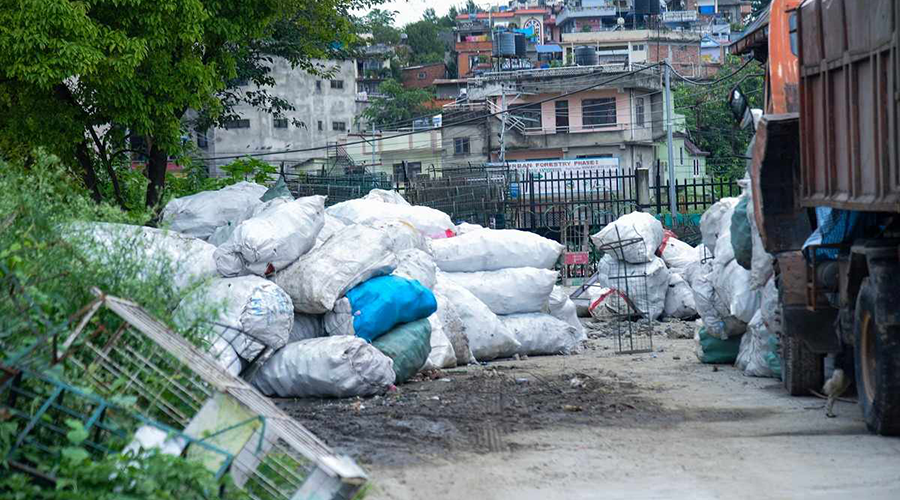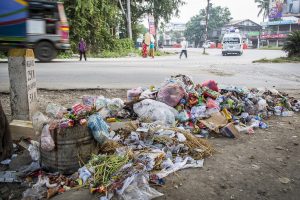
The operation of a proper health care system is signified by an efficient hospital waste management system. Any hospital, before it is planned to be built, should have set a tactful management idea because of the hazardous nature of the wastes that generate out of an operation of a hospital. The hospital waste simply refers to any waste that comes out of a hospital in the course of diagnosis, treatment, medication, surgery of patients. It includes chemical wastes, expired drugs, sharp objects like needles, anatomical wastes that come from surgeries or delivery of an offspring, radioactive wastes, food wastes that come out of hospital cafeteria, paper wastes that come out of record files and even technological and biomedical equipment waste that is generated once the technology is no longer in the condition to serve its purpose. Generally, hospital waste comprises 80% of normal healthcare wastes. But, what is more important is how the hazardous wastes are being disposed of.
In the current situation of the Covid-19 pandemic, hospitals across the world have become centres of attention. Because they are directly involved in the treatment of patients in such a health emergency, they should be more cautious about waste management so as to avoid any waste disaster. It is challenging in emerging economies given the limited availability of resources. However, if planned properly, such countries can also adopt the best possible practices in hospital waste management.
Composition and categories of hospital waste
An efficient healthcare management system aims to ensure public health as well as safety, provides a hygienic environment, and reduces the amount of waste that is generated. It reduces the negative impacts of waste treatment and disposal and makes sure that health and environmental security is maintained. Only about 15-20% of the waste produced in hospitals is hazardous, so one of the vital parts of a hospital waste management system should be about segregating wastes properly. That way, the remaining 80%, if not mixed with hazardous wastes can be treated under safe and normal conditions because those wastes come out of the administrative section, canteen, housekeeping services, construction and demolition wastes and wastes that are produced due to maintenance of hospital infrastructures.
For proper segregation, storage, transport, treatment, and disposal of wastes, firstly, the categorisation of hospital biomedical wastes is a must. The following chart provides a guideline for such a categorisation:

The second table here is an example of the waste division of Health Care Institutions Waste according to Bio-medical Rules, 1998 of India.
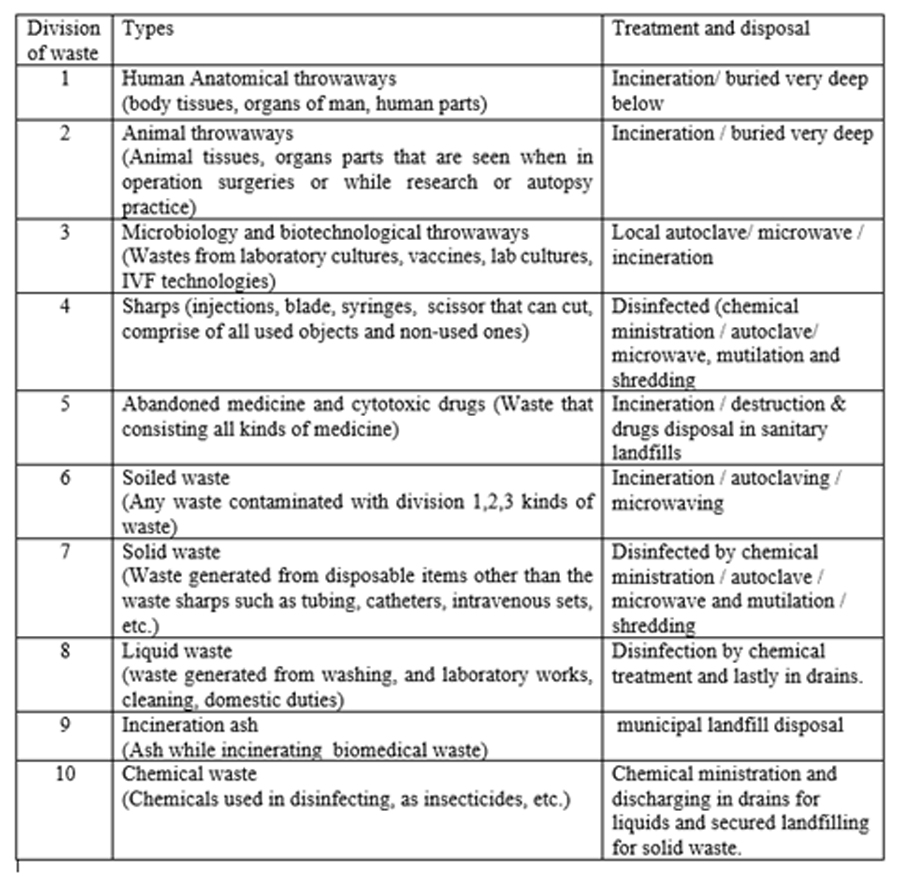
Source: BMW rule, India
Segregation of waste
The segregation of waste is the separation of the waste according to nature and placing them in colour-coded bins. It is a very important step in hospital waste management because proper segregation guarantees effective bio-medical waste administration. The healthcare wastes should be segregated as per the guidelines mentioned above.
How does segregation help?
Effective segregation prevents unnecessary further treatment of wastes because if hazardous wastes are separated tactfully, almost 80% of the hospital wastes that are of non-hazardous nature can be treated as general municipal waste. It also helps prevent volunteered reuse of syringes and other objects. Most importantly, it encourages the recycling of recyclable objects after sterilisation and disinfection. For example, recycling of plastic materials can be done for inedible use. It saves the treatment process from unnecessary expenses.
Colour notation and bins’ marking
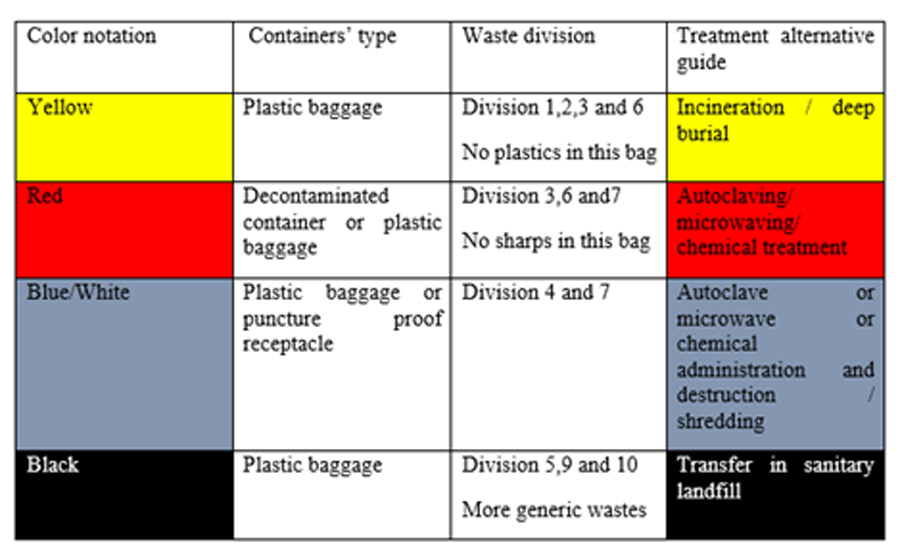
The bins and bags should have certain labeling as per the guideline of the World Health Organization (WHO) and the labels should mandatorily be non-washable and should be prominent.
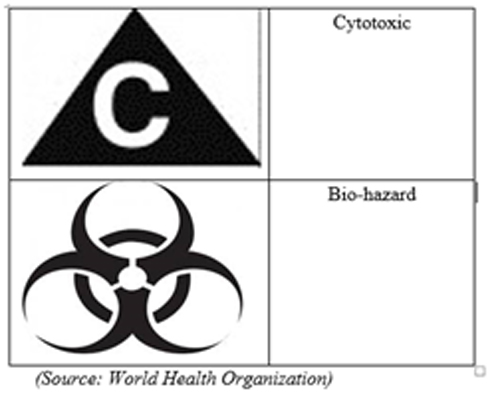
Collection of hospital waste
While collecting the hospital wastes, the Clinical staff and sweepers should always wear protective gears including masks, protective apron, protective boots, and heavy-duty gloves. The nature of Covid-19 has encouraged to use protective glasses too because the virus could be transmitted through eyes as well. The bins should have plastics with the same colours of the bins and should be washed or disinfected before changing the bags. The waste collection should be done at least once a day or more frequently as per the need. The bags should be sealed very well to prevent spillage while transporting the waste for necessary treatment. Sharp throwaways must be placed in puncture-proof baggage. The wastes must be gathered from all subunits like OT, laboratory, ICU, wards, corridor, cafeteria, etc.
Storage of hospital waste
The hospital waste should be stored in a proper place after collection before passing onto the transport and treatment parts. The segregated wastes must be collected in labelled and symbolised containers. The duration of storage should not cross eight to 10 hours in major and big hospitals and 24 hours in nursing homes. The unit central storage should be located near the incinerator if present and near the food preparation areas in no case. The storage room should be spacious enough to fit all the hazardous wastes and it should have space to transport the waste too. Only the yellow bag should be stored in the storage facility area. The storage area should be thoroughly cleaned based on the waste management plan.
Transportation of hospital waste
The waste should be hauled either in trolleys or wheelbarrows; manual loading shall not be a priority. The waste bags should be tied or sealed and the waste about to be transported for further treatment should be recorded and signed by medical staff mentioning the date and shift. The drivers and other concerned staff should wear PPEs and have knowledge about different categories of the waste that they transport. The vehicles should be special to prevent direct contact with the haulage operators. The consequences of any accident of the transportation vehicles should be considered before designing the vehicle and the driver should be trained with accidental reflexes that need to be compulsorily conducted so as to prevent the hazards that could have been created by accidents.
Treatment of hospital waste
Several methods are adopted to treat the hospital waste according to the nature of the waste and its treatment requirement. Some waste materials are incinerated; some are chemically treated and ended in a landfill; some waste materials need microwave treatment; some need encapsulation, intertisation, etc. Treatment measures should envision waste treatment strategies well. A proper treatment technique must be undertaken so that the treatment measure does not disregard environment regulation plans. The calculation of the consequences of waste treatment measures needs to be done and a rational choice should be made. The summary of the guidelines that have been mentioned by the WHO, the Indian BMW guidelines as well as the National Health Care Waste Management of Nepal is tabulated below:
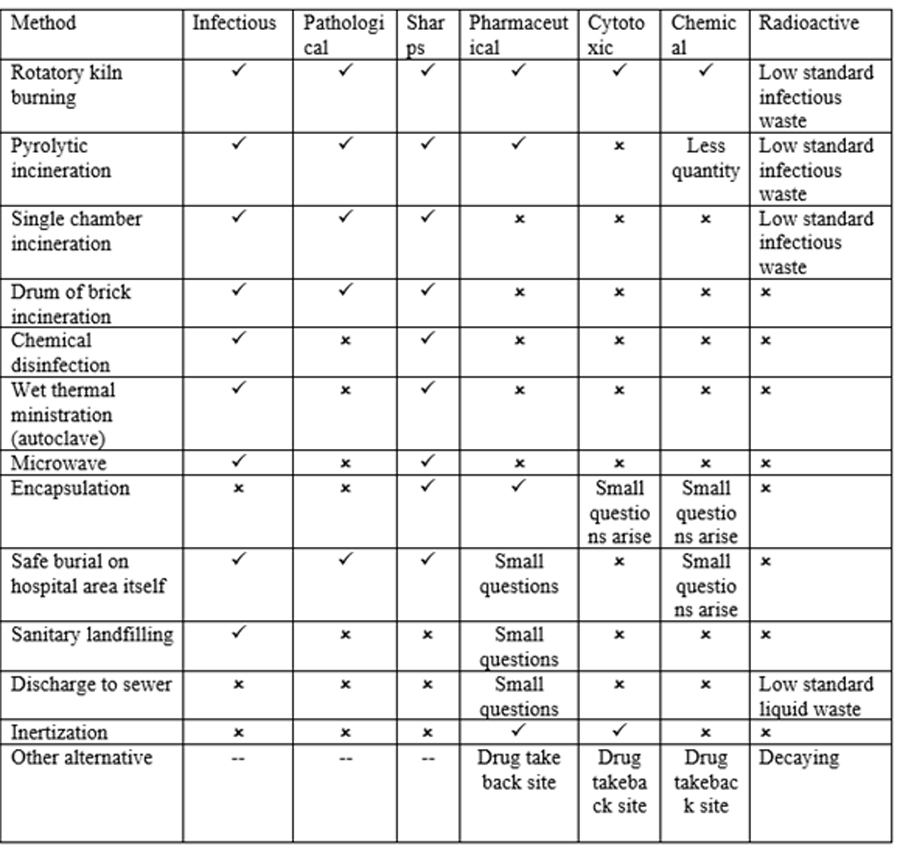
Different countries follow their own sets of treatment measures according to their financial state as well as their expertise.
Disposal of hospital waste
According to the waste and microorganism present in it, the waste should be rendered inactive and disposed of with suitable irradiation, incineration, thermal, chemical treatment, or by blending several techniques. The treatment strategies should be conducted only after an environmental impact assessment (EIA) is carried out. The hazardous waste should be burnt no later than 24 hours. Ashes from the incinerators are dealt like municipal waste is buried. Landfill sites should be far away from a river system or the area with risk of surface water contamination. Hazardous waste should be buried deep. The landfill operator should be properly trained before exercising landfill activities. The municipality should ensure that subsurface water contamination has not occurred. There should be no flexibility in rules, and the provision of PPEs is a must.
Challenges of hospital waste management in emerging economies
Healthcare management is one of the major challenges in developing countries. According to a survey in Nepal, about 10-20% of the budget in a hospital facility is for the management of hospital waste. About 27% of hospital waste is mixed with general waste. A survey in Pakistan also mentions that hospitals are not efficient enough to control their effluent quality. Thailand has better medical facilities compared to Mongolia. India also faces some challenges due to the emission of different substances that hamper environmental quality. Only in Nepal, there are about 6,000 healthcare institutions including hospitals, nursing homes.
Different countries conduct many seminars and training programmes for the proper management of biomedical wastes. But, there has been inadequacy that still prohibits emerging countries from managing their hospital wastes in a scientific and more-coordinated way. The risks of hospital waste are beyond comparison to the risks of general non-hazardous wastes. Incineration of hazardous wastes leads to the emission of dioxin, furans, and even mercury is produced. This poses environmental degradation and induces health risks as well.
Hazardous hospital waste also has a negative impact on the health of patients, health workers, and even the general public. In Nepal, about 15-20% of hospital waste is contagious. But, it was also found out that 67% of people die due to non-communicable diseases. The emissions from the incinerators or different other management techniques contribute to induce non-communicable diseases like cancer. Mismanagement of sharp objects like needles is responsible for many new cases of HIV, Hepatitis B, and Hepatitis C among people. But, lessons should be learned from past mistakes and better treatment options should be opted.
Most importantly, some countries also lack facilities of occupational health training, due to which, drivers or other waste management team members are unaware of the waste composition that they have been dealing with. The PPEs are not supplied in a good quantity in the waste management team, due to which, they are exposed to higher infection possibility and chemical burns from hazardous waste.
The WHO also mentions that about 23% of death cases are due to environmental hazards. However, all these problems can be overcome if the hospital waste management policies are strong enough. Not just governmental bodies, but private sectors, NGOs, INGOs, the community should leave no stone unturned to ensure that sustainable waste management is done in an efficient manner. The health facilities should work hand in hand with private sectors for the provision of safe drinking water, sanitation, and hygiene. WASH and integrated waste management systems should be assured of clean and sustainable management in order to overcome challenges related to hospital waste management.
Conclusion and recommendations
The challenges of hospital waste management can be dealt with many measures. Management of hospital waste is not just related to a hospital but also is linked directly with the hospital community, society, nation, and world as a whole. The Covid-19 pandemic has triggered awareness in people about how vital the hospital waste management process in every single country can be. The PPEs should be compulsory in any situation regarding management and there should be no carelessness in any unit of the management team. Every treatment unit like a placenta pit operator or microwave operator or other unit operators should fulfill every ritual necessary for safe management. Technology transfer should be done among many countries so that proper administration techniques can be adopted in different countries. The efficient disposal of PPEs is equally important. Policies and rules should be followed and improvement opportunities should always be sought. The use of colour-coded bins and the use of labels according to the nature of the hazard of wastes should be ensured. Capacity-building among health workers should be envisioned. If all these criteria are met, there will not be any biomedical waste disaster.
Adhikari and Parajuli are associated with the Environmental Engineering Programme of Kathmandu University.





